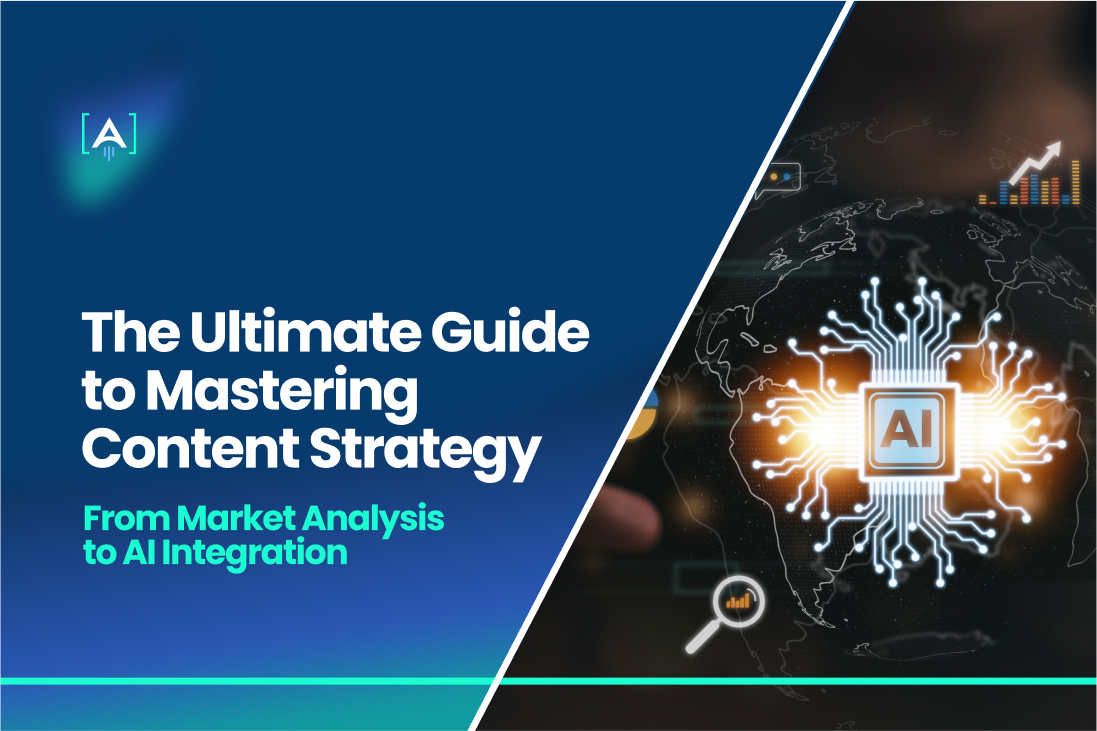With the emergence of AI tools, the content creation process may seem effortless, but maintaining your brand voice and originality while delivering valuable insights remains principal.
Gone are the days of content creation for content’s sake. In today’s landscape, an effective AI content strategy is crucial.
In fact, Google’s latest updates have cracked down on low-quality and unhelpful content, reducing it by 45%.
But here’s the kicker: when you use AI tools just right, you don’t just create content – you craft experiences.
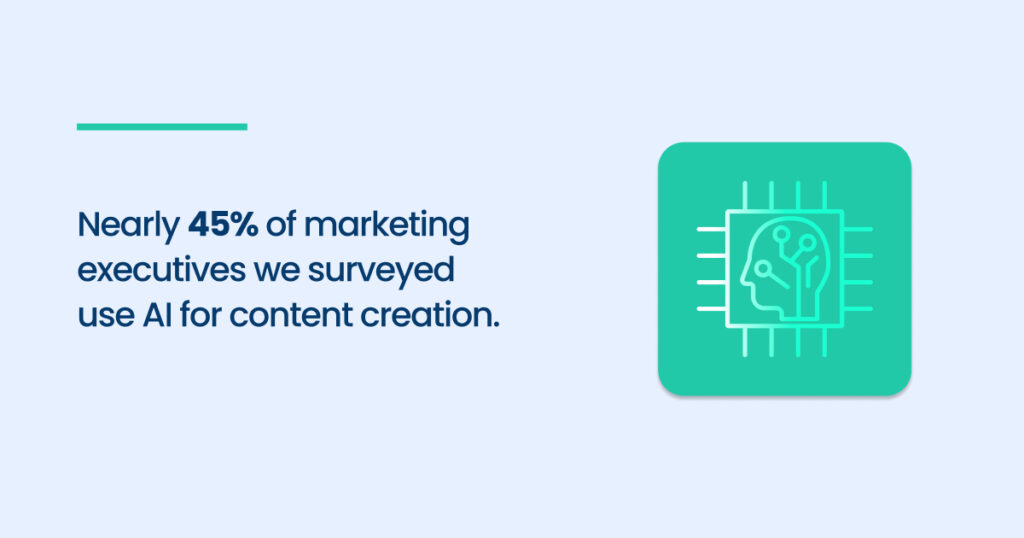
(source)
That’s what this blog post is all about – mastering the art of AI content strategy with the help of an expert content marketing agency.
We’ll show you how to use AI tools to create AI content strategies that stand out and resonate deeply with your audience, driving meaningful engagement and results.
What is AI Content Marketing Strategy
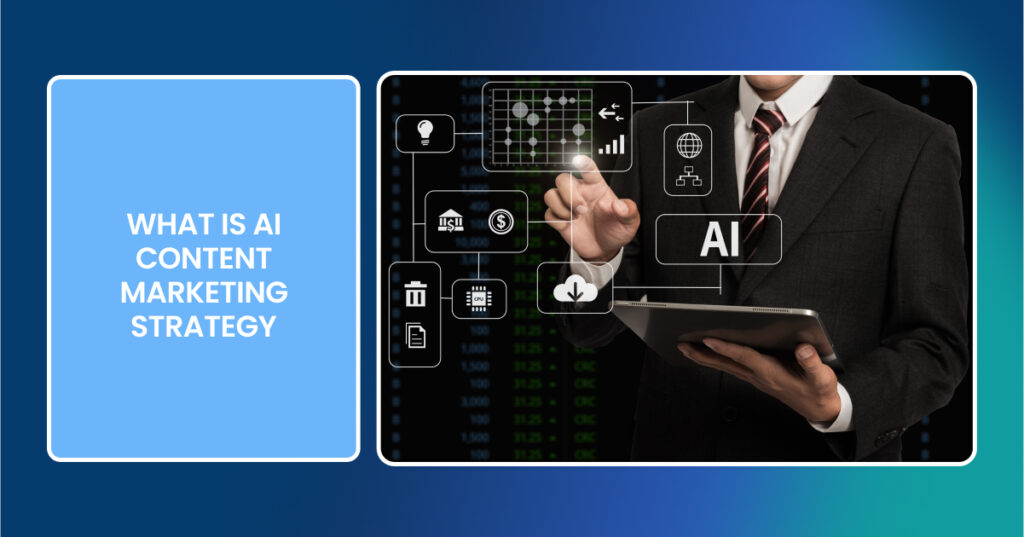
AI content strategy is about leveraging AI-powered tools to create content more effectively and strategically.
- Saves time and effort: AI tools automate repetitive tasks like data analysis and content generation, freeing up your time for strategic planning and creativity.
- Improves content relevance: By analyzing data and trends, AI tools ensure your content is always relevant and aligned with your audience’s interests.
- Improves personalization: AI tools can segment your audience and tailor content to specific demographics or preferences, increasing engagement and conversion rates.
- Boosts efficiency: With AI tools, you can streamline content production workflows, from ideation to distribution, leading to faster turnaround times and improved productivity.
- Drives better results: A well-executed AI content strategy optimizes content based on data insights, helping you achieve higher search engine rankings, increased traffic, and improved ROI.
How to Create a Content Marketing Strategy
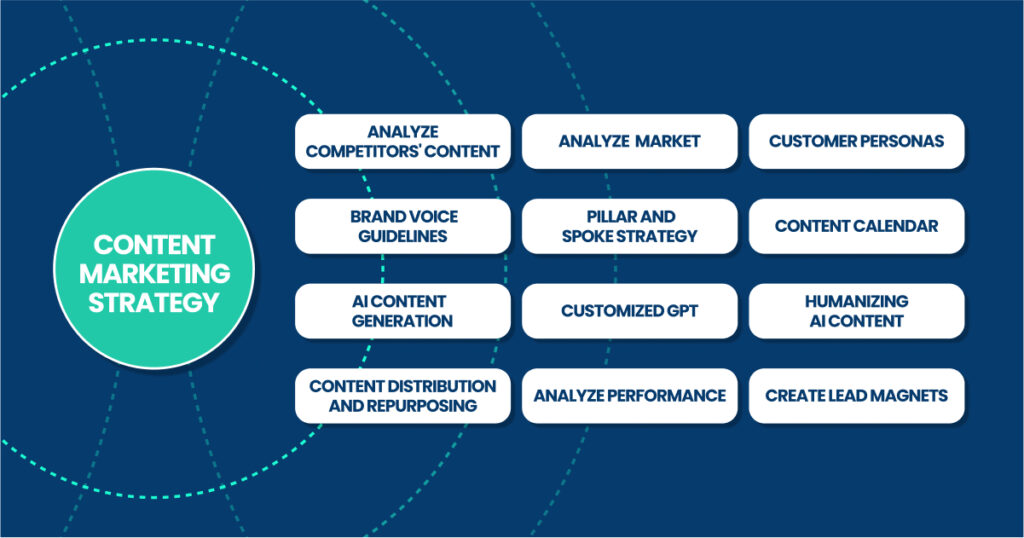
Let’s learn to create a digital content marketing strategy step by step.
In this section, we’ll break down each stage, guiding you through creating a content marketing strategy that stands out and drives meaningful engagement.
1. Analyze Competitors’ Content
Before developing your own strategy, it’s essential to examine your competitors’ activities.
This will help you understand what’s working and what’s not in your industry.
- Identify your main competitors: Start by listing out the brands or businesses vying for your target audience’s attention. These could be direct competitors offering similar products or services or indirect competitors targeting the same audience differently.
- Scope out their content: Once you have your list, it’s time to roll up your sleeves and dig into their content. Check out their website, blog, social media profiles, and any other channels where they’re active. Take note of the topics they cover and the engagement they receive.
- Analyze their strategy: Look beyond the surface and try to uncover the strategy behind their content. What themes or messaging do they consistently use? Are there any patterns in the types of content they produce or the formats they use? Pay attention to how they engage with their audience and any tactics they use to drive traffic or conversions. Understanding their content marketing funnel will give you insight into how they move prospects from awareness to conversion.
- Identify keywords and content gaps: As you sift through your competitors’ content, look for keywords they’re ranking for and topics they’re covering to differentiate your own content and fill in any gaps in the market.
Tools for Competitors’ Keywords Tools
- SEMrush: SEMrush offers robust competitor analysis tools, including keyword research, backlink analysis, and domain comparison. It shows your competitors’ organic and paid search strategies.
- Ahrefs: Ahrefs is a powerful SEO tool that offers comprehensive competitor analysis features. It analyzes your competitors’ backlink profiles, organic search traffic, and top-performing content.
- SpyFu: SpyFu specializes in competitor keyword research, providing data on your competitors’ organic and paid search keywords, ad campaigns, and rankings. It helps you identify lucrative keyword opportunities and track your competitors’ strategies over time.
2. Market and Data Analysis
Now that you’ve scoped out your competitors, it’s time to zoom out and take a broader look at the market landscape. Here’s how to do it:
- Understanding the market landscape: Start by getting a clear picture of the overall landscape in which your business operates. Who are your target customers? What are their needs, pain points, and preferences? What trends or developments are shaping your industry?
- Analyzing relevant content and data: Once you have a solid understanding of the market, it’s time to dive into the data. Look at metrics like website traffic, social media engagement, and email open rates to gauge how your audience interacts with your content. Identify which topics or formats resonate most with your audience and which may need improvement.
For example, if you have a law firm and you notice that your audience is highly engaged with your blog posts about estate planning, you might decide to create more content around this topic or even develop a downloadable guide or webinar series to provide further value to your audience.
Tools for Market and Data Analysis

Let’s equip you with tools to understand your market and analyze user data effectively.
- Google Trends: This tool gives you insights into what people are searching for online. It helps you understand popular trends and topics among your target audience.
- Social listening tools: Platforms like Hootsuite or Mention allow you to monitor social media conversations. You can see what people say about your industry, competitors, and related topics.
- Industry reports and publications: Look for reports and publications specific to your industry. Get valuable insights into social media trends, consumer behavior, and competitor analysis.
- Google Analytics: Understand how people interact with your website. You can see which pages are popular, where your traffic is coming from, and more.
- Content performance platforms: Platforms like BuzzSumo show you how your content performs across different channels. You can see which content pieces get the most engagement and shares.
- Customer Relationship Management (CRM): By centralizing customer data and interactions, customer relationship management systems provide a comprehensive view of each customer’s journey, from initial contact to post-sale support. With CRM, you can segment their audience, personalize communications, and automate workflows to deliver targeted and relevant content
3. Creating Customer Personas
The next step is understanding your audience by creating detailed customer personas.
- Identifying target audience segments: Start by segmenting your audience based on demographics, behavior, and psychographics. This helps you group similar customers and tailor your content to their needs and interests.
- Developing detailed customer personas: Once you’ve identified your audience segments, dive deeper into each group to create detailed customer personas, including age, gender, job title, interests, pain points, and goals.
Gather insights from market research, customer surveys, and CRM data to create personas.
You can also leverage ChatGPT by providing prompts to generate realistic customer personas based on your criteria.
4. Establish Brand Voice Guidelines
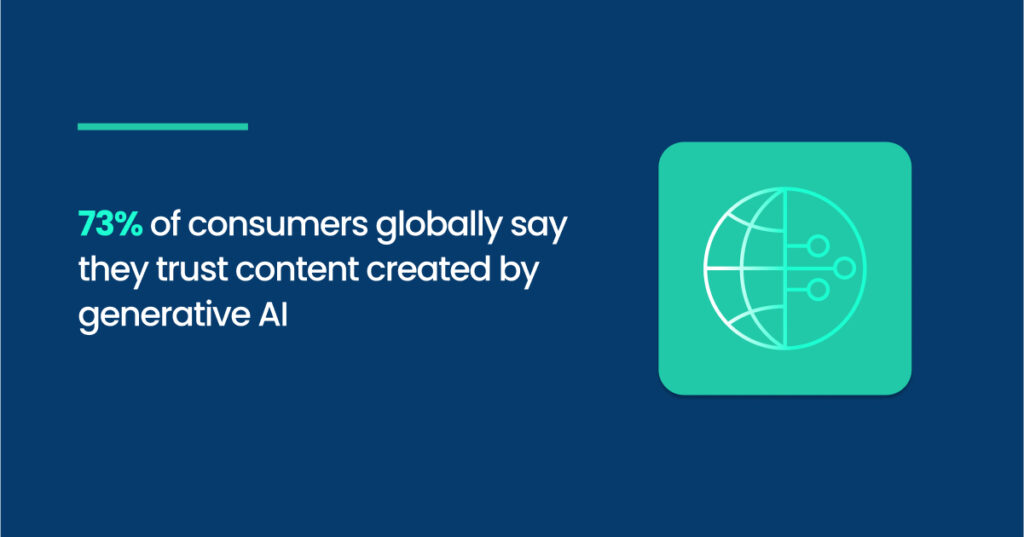
(source)
The next crucial step is to provide clients with a definitive guide on establishing brand voice guidelines.
Let’s see how crafting these guidelines will strengthen your content creation efforts and fortify your brand’s presence.
- Collaborating with clients to define brand voice: Start engaging with them to understand their vision, values, and personality. Discuss what sets their brand apart and how they want to be perceived by their audience in the digital marketing landscape.
- Crafting guidelines for consistent messaging: Based on the insights gathered, work with your clients to develop clear and concise guidelines for brand voice. Define key attributes such as tone, style, language, and messaging pillars that reflect the brand’s identity and resonate with its target audience.
5. Implement a Pillar and Spoke Strategy
Let’s explore implementing a Pillar and Spoke strategy to organize and amplify your content marketing plan.
Among various content marketing strategies, the Pillar and Spoke strategy is a powerful approach to organizing and advancing your content efforts. Here’s how it works:
- Defining main categories (pillars) and subtopics (spokes): Identify general themes or topics that align with your content strategies. These will serve as your main pillars. Then, break down each pillar into subtopics or spokes that delve deeper into specific aspects of the main theme.
For example, if you’re in the wellness industry, your main pillars could be “Nutrition,” “Fitness,” and “Mental Health.”
Under the “Nutrition” pillar, you might have spokes like “Healthy Eating Habits,” “Meal Planning,” and “Superfoods.”
- Structuring content for comprehensive coverage: Once you’ve defined your pillars and spokes, organize your content creation efforts around this framework. Create cornerstone content pieces for each pillar that provide in-depth topic coverage. Then, create supporting content pieces (spokes) that explore related subtopics or provide additional insights.
For instance, if your pillar is “Digital Marketing Strategies,” your cornerstone content piece could be a comprehensive guide to “Content Marketing.”
Then, you can create supporting content pieces that delve into specific aspects of content marketing, such as “SEO Strategies,” “Social Media Marketing,” and “Email Marketing Tips.”
6. Develop a Content Calendar

Next, let’s dive into the importance of creating a content calendar.
This tool helps you plan your content production and publication schedule, ensuring your content creation efforts are well-organized and aligned with your marketing goals.
Here’s how to develop a content calendar that keeps you on track and maximizes the impact of your AI content strategy.
- Plan your content production: Begin by deciding what types of content you’ll create, like blog posts, videos, or social media updates. Figure out how often you’ll publish content based on what your audience likes and engages with the most.
- Connect content with marketing goals: Make sure every piece of your content has a clear purpose that aligns with your marketing objectives, whether building brand awareness, attracting leads, or boosting sales.
- Use tools for efficiency: Take advantage of tools to streamline your content planning process. Consider using tools like Google Calendar, Trello, or CoSchedule to organize your content calendar and keep your workflow efficient.
7. Leverage AI for Content Creation
Let’s move on to leveraging AI (artificial intelligence) for content generation.
Here’s how you can use AI tools to improve your content creation process, freeing up more time for research and strategy:
- Use AI tools to improve content creation: Incorporate AI-powered tools into your workflow to streamline content creation. These tools employ natural language processing and AI algorithms to generate high-quality content efficiently. By leveraging AI for tasks like generating ideas, writing drafts, and editing, you can speed up your content creation process and produce more engaging content.
- Allocating more time for research and strategy: With AI handling repetitive tasks in content creation, you’ll have more time to focus on research and strategy. Dive deeper into understanding your audience’s needs and preferences, exploring new trends in digital marketing, and refining your AI content strategies. By leveraging AI content strategy, you can optimize your content creation process and drive better results.
8. Customize GPT for Client-Specific Needs
Customizing GPT for client-specific needs is crucial in your AI content strategy. Here’s why:
- Tailored AI content: By customizing GPT for each client, you ensure that the AI-generated content matches their brand voice, style, and objectives. This personalized approach helps to maintain consistency and relevance in your content marketing efforts.
- Enhanced engagement: When AI content resonates with your client’s audience, it leads to better engagement and interaction. Customizing GPT allows you to create content that speaks exactly to the interests and preferences of the target audience, driving meaningful connections and results.
- Brand representation: Your client’s brand is unique, and AI content should reflect that. By customizing GPT, you can ensure that the content accurately represents the brand identity, values, and messaging, reinforcing brand loyalty and customer trust.
Guidance to Creating Tailored GPT
Here are some best practices for creating tailored GPT instructions for each client in your AI-powered content creation:
- Understand the client’s brand: Take the time to familiarize yourself with the client’s brand identity, tone, and style. This includes their messaging, values, and target audience. By understanding their brand, you can ensure that the AI content reflects their unique voice and resonates with their audience.
- Provide specific guidelines: Communicate the client’s content requirements, preferences, and objectives to GPT. Provide specific prompts, keywords, and examples to guide the content generation. This helps GPT understand what type of content to produce and ensures alignment with content marketing strategies.
- Incorporate feedback: Regularly gather feedback from the client on the AI-generated content. Use this feedback to refine and adjust the instructions for GPT accordingly. Pay attention to what resonates with the audience and what doesn’t, and make necessary adjustments to improve the quality and relevance of the content.
- Stay flexible: Content needs may evolve over time, so be prepared to adapt and update the instructions for GPT as needed. Stay informed about changes in the client’s brand, audience preferences, and content marketing goals, and adjust the instructions accordingly to ensure continued success in AI-generated content creation.
9. Edit and Humanize AI-Generated Content
This phase is crucial in content marketing as it ensures that your content maintains quality standards and resonates with your audience personally.
While AI tools can guide and simplify your work—Google accepts it—your AI-powered content creation must be accompanied by human input to add that special touch of authenticity and connection.
Blending AI content strategies with human creativity allows you to produce content efficiently and ensure it speaks to your audience on a deeper level.
A well-crafted AI content strategy enhances this process by providing data-driven insights, while human intervention ensures the content retains its personal and relatable touch.
Let’s explore how blending AI tools with human creativity can upgrade your content marketing strategies.
Steps to Perfect AI Content
Ensuring content quality through revisions is a crucial step in refining AI-generated content. Here’s how you can do it:
- Review for accuracy: Start by checking the content for factual accuracy and relevance. Ensure that the information provided is up-to-date and aligns with your content marketing objectives.
- Check for coherence: Review the flow and organization of the content to ensure that it makes sense and follows a logical structure. Look for any inconsistencies or gaps in the narrative that need to be addressed.
- Assess readability: Evaluate the readability of the content by checking for grammar, punctuation, and spelling errors. Ensure that sentences are clear and concise and that the overall tone is appropriate for your target audience.
- Optimize for SEO: Optimize content for search engine rankings by incorporating relevant keywords and phrases. This can help improve the content’s visibility and reach online.
- Seek feedback: Finally, gather feedback from colleagues or peers to get fresh perspectives on the content.
10. Distribute and Repurpose Your Content

To complete your content marketing efforts, you must distribute and repurpose your content.
Let’s explore how these strategies can amplify the impact of your content marketing efforts.
Identifying Main Channels for Content Distribution
- Understand your audience: Start by understanding where they spend their time online – Facebook, Twitter, or Instagram. Do they prefer reading emails or browsing websites?
- Research platforms: Once you know your target audience, research the platforms that align with their preferences. Look for platforms where your target audience is most engaged and where your content will likely resonate.
- Consider content types: Different content types perform better on different platforms. For example, images and videos may perform well on Instagram, while long-form content like blog posts may better suit LinkedIn or Medium.
Repurposing Long-Form Content
Repurposing long-form content is like giving it a new lease on life. Here’s how you can implement in content marketing:
- Break it down: Take your long-form content, whether it’s a blog post or an article, and break it down into smaller chunks. These chunks can then be repurposed into social media posts, email newsletters, or even bite-sized videos.
- Get creative: Don’t be afraid to get creative with your repurposing efforts. Turn a blog post into a visually attractive infographic, an insightful podcast episode, or a series of Instagram stories. The possibilities are endless!
- Cater to different audiences: Each platform caters to a different audience, so tailor your repurposed content accordingly. What works on Facebook may not work on LinkedIn, so be sure to adapt your content to fit the platform and its audience.
- Revisit and refresh: Finally, don’t forget to revisit and refresh your repurposed content regularly. Update statistics, add new insights, or tweak the messaging to keep it relevant and engaging.
11. Analyze Your Content Performance
If you overlook this crucial step, your content marketing journey might be incomplete. You must measure the effectiveness of your content marketing efforts.
Keep an eye on key metrics like:
- website traffic (users visiting your website)
- engagement rates (how engaged they are with your content)
- click-through rates (how often they’re clicking on your links)
- conversion rates (how many of them are turning into customers)
Adjust Strategy Based on Data Insights
After gathering information on how your content is doing, use these findings to improve and fine-tune your content marketing plan.
Recognize any recurring trends, spot patterns, and pinpoint areas that need enhancement, then adapt your strategy accordingly.
This could mean modifying your content topics, adjusting where you share your content, or refining your message to better resonate with your audience’s interests and requirements.
12. Create Value-Added Lead Magnets
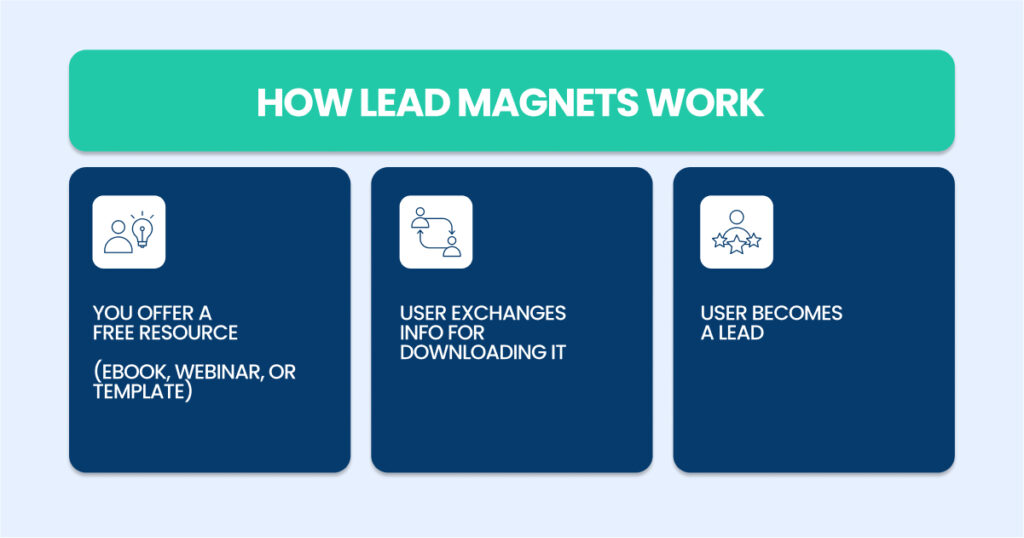
This is a great content marketing technique to boost reader engagement and conversions.
Developing lead magnets means making tempting offers that prompt readers to take action, like signing up for a newsletter or grabbing a free ebook.
These offers should tie closely with your content and give extra value to your audience.
Offering these lead magnets enhances reader engagement by giving them helpful things that meet their needs.
Plus, it boosts conversion rates by encouraging readers to take the next step, like making a purchase or signing up for your services.
In short, creating value-added lead magnets benefits both you and your audience, providing helpful resources while adding engagement and conversions in your content marketing efforts.
Maximizing Content Marketing: Key Takeaways
In wrapping up, here are the key takeaways from our exploration of content marketing with AI tools:
- AI-powered content creation: AI tools can significantly streamline and enhance your content creation process, making it more efficient and effective.
- Tailored content strategy: Customizing your AI content strategy to fit your audience’s preferences and needs is essential for success in content marketing.
- Human touch: While AI can assist in content creation, adding a human touch through editing and personalization is crucial for creating authentic and engaging content.
- Content distribution and repurposing: Identifying the proper channels for content distribution and repurposing long-form content into various formats can extend its reach and impact.
- Data-driven optimization: Implementing AI content strategies allows for analyzing content performance metrics and adjusting your approach based on data insights, which is key to continuously improving your content marketing efforts.
Hire a Content Marketing Agency Like [A] Growth
At [A] Growth Agency, we offer end-to-end content marketing services to add value to your brand.
We analyze and optimize your current content for maximum impact and effectiveness.
Our team collaborates with yours, providing guidance and coaching throughout the content creation process.
As a performance-based partner, we offer revenue sharing to reward your success.
We ensure consistency across all your content by developing User Personas and Content Style Guidelines.
So, if you need our help,
